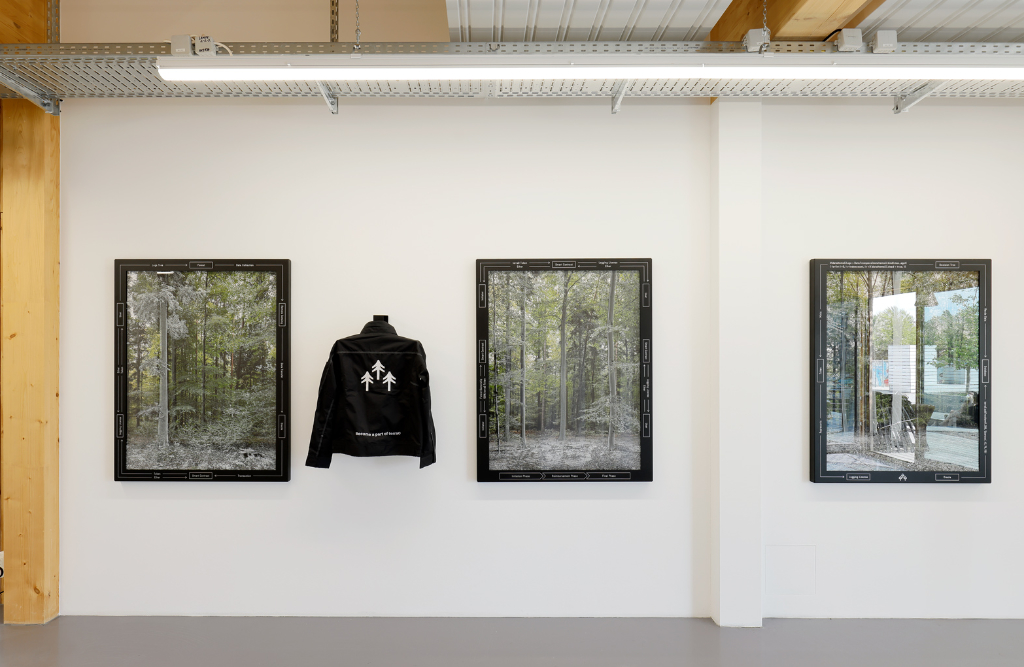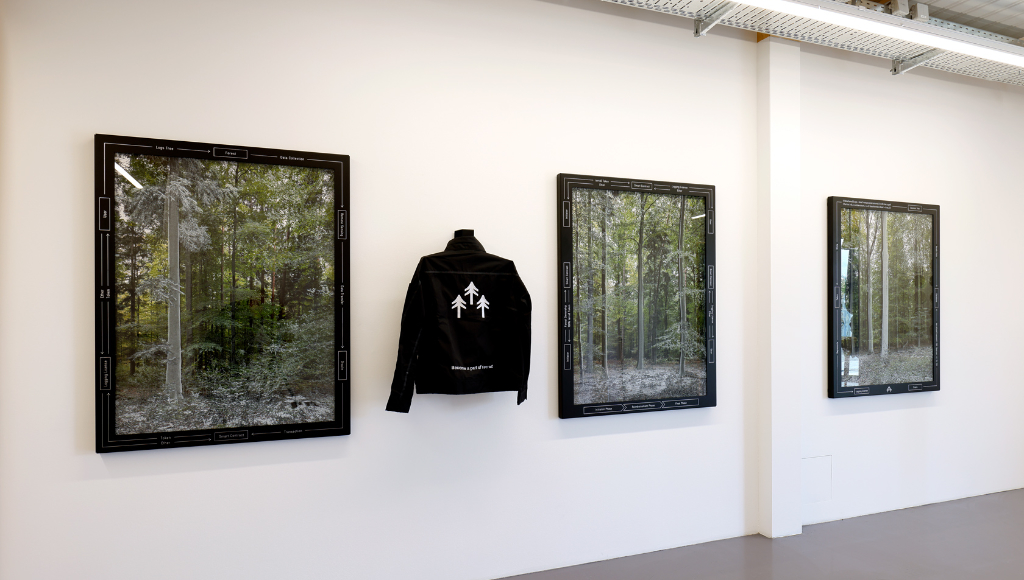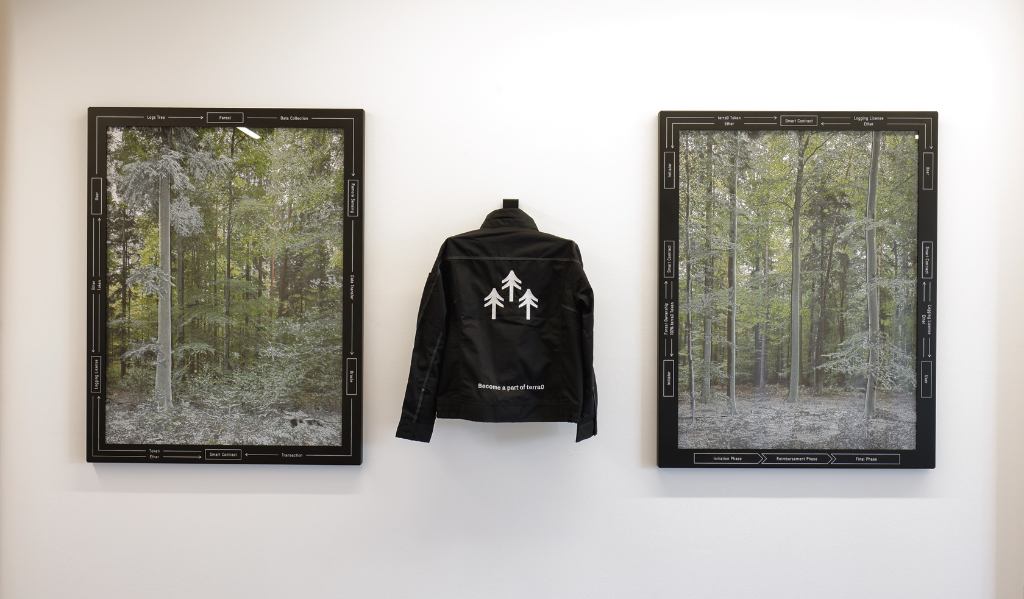Interview by Leoni Fischer

If we continue to restrict ourselves to viewing nature as a domain, work tool, or material, rather than a partner, everything is over. (Günther Anders, 1955)1
Sixty-five years after the philosopher Günther Anders concluded his work on “the state of the Soul in the second industrial revolution”, its message remains of undiminished relevance. Today, due to the development of artificial intelligence and blockchain technology, the fulfilment of his demand seems, in fact, only a few clicks away. terra0, a project developed by Paul Kolling, Paul Seidler and Max Hampshire at the Berlin University of the Arts in 2020, shows that ecosystems could soon become equal “business partners” instead of subordinate producers of raw materials.
Since the establishment of cultural landscapes as a dialectical counterpart to “untouched nature”, forests have been thought of as production fields overseen by human management. The terra0 framework built on the Ethereum network turns this hierarchy on its head, placing the human as a service provider to an autonomously operating forest. The foundation of the forest’s autonomy lies in a smart contract – a decentralised program stored on the blockchain.
Data sets such as topical studies or satellite images are collected and fed into another program called “Oracle”, where the information is processed to inform the decisions the smart contract makes. If, for example, a specific number of trees have reached a certain height, the smart contract automatically decides to log a predefined percentage of them.
Of course, the forest cannot cut down its trees by itself – instead, the system issues logging licenses to companies or individuals. However, to operate economically in this way, the forest must first come into possession of its land. In this initial phase, it produces wood to pay off its shareholders. The ecosystem, therefore, repurchases itself through the production of raw materials.
As with all artificial intelligence applications, the degree of autonomy the forest ultimately has depends on the parameters based on which it operates and “learns”. These could be set towards any goal: to enable more sustainable forestry or make wood production even more profitable.
Thus, it becomes clear that the forest owning itself does not automatically mean the end of its role as a material supplier. The main condition for its autonomy is to keep participating in economic wood production. This raises questions about the terms of personhood for ecological or technological actors and humans. In a capitalist society, one has to work and produce to survive.
But outside of a globalised, capitalist system, forests wouldn’t need to be managed by an AI at all. Therefore, the concept of an augmented forest means its freedom under capitalist realist conditions. Instead of “natures” liberation from human exploitation, it only declares the forest’s right to participate in a human-made system as an equal actor.
Without a doubt, this reconfiguration could have many positive effects concerning wildness-creation and ecosystem preservation. For example, an augmented forest could use its profits to cross-finance programs helping to sustain other ecosystems connected to it. Nevertheless, the question remains whether this was how we imagined achieving the long-overdue resolution of the nature/ human binary.
What’s striking about terra0 as a project is how successfully it has branched out into other fields outside of the arts, for example, by publishing a scientific paper on the framework and its possible implementation scenarios. Yet, the work remains firmly rooted in the context of the arts. The arts and their institutions can play an essential role as alternative public forums to put visionary ideas up for discussion.
As a kind of artistic „front end“ to the terra0 framework, the “terra0 morphology panel[s] 01-03” (2020), which have recently been displayed as part of the group exhibition SynchroniCities in Berlin, function as discursive objects, reliably sparking heated discussions between viewers.
The work comprises three large panels, each holding a colour photograph of a dense forest. The trees are partially traced over by the second layer of fine white dots, stressing the depth of the tree trunks and leaves in a pointillistic yet clearly technological fashion. It appears as technical mimesis of the forest’s natural shapes.
Black metal frames span the pictures of the forest and its quantified self. A functional diagram is engraved in fine silver lines on their powder-coated surface, visualising the terra0 framework’s inner workings as a third layer. Due to the framework character, terra0 doesn’t seek to suggest any predefined interpretation.
Following Umberto Eco’s understanding of the open artwork, one could describe the work’s recipient as a fourth layer, enriching it with countless possible meanings and implications. Two black work jackets complete the ensemble. The three pictogram-like trees comprising the terra0 project logo are stitched on their backs. Alongside, it reads, “Become part of terra0.” Being addressed directly as a potential future employee of an augmented forest, one can start to think about human labour’s role inside the framework.
What would it mean to work for an intelligent ecosystem? This and many other questions remain unanswered. But thanks to artworks like terra0, the reception of art could not only offer a forum to discuss and test speculative ideas; it could also be seen as a kind of buffer space in which we could take the time to reflect on new technologies like AI, whose development has been moving at a much faster pace than our ability to process the full extent of their potential consequences.


How did the project terra0 come to be?
The original concept was developed in 2015/16 in the New Media class of Joachim Sauter at the Berlin University of the Arts. We researched crypto-governance, economics and questions about the representation of natural systems in the techno-sphere. As a new technology, smart contracts seemed particularly interesting to us: the possibility of decentralised programs to manage the property was not discussed outside a cryptocurrency-specific bubble until then.
The result was a theoretical framework describing how a forest plot could become an autonomous economic actor through technological and economic augmentation. We published our findings in May 2016 under the title terra0 — Can an augmented forest own and utilise itself?. In 2017, the project received greater attention after being presented at Transmediale 2017 and published in the book Artists Re: thinking the Blockchain.
We constructed different experiments to investigate various aspects of the overall terra0 construct. These experiments always investigate specific parts that interest us: How can living organisms be represented in a crypto-financial system? In 2018, this led to Flowertokens, an installation at Trust Berlin. Can a tree act as an autonomous contractor? This perhaps absurd question led to Premna Daemon, exhibited at the Schinkel Pavillon in the Proof of Work exhibition.
In what way does the project change the relationship between forests and humans?
Robert Harrison argues that the image of forests always reveals the parts, desires and fantasies that have been spurned in culture. The European forest throughout history always reads as a place occupied by the repressed — like a mirror. As Harrison shows: the origin of the word forest (the Latin word foris can be translated outside or outside the city/state) manifests the institution’s relationship to nature.
The forest is apparently outside the nomos. The city continually defines itself outside the hinterland, the “brachland”, and the forest. But that’s just half of the story; the other part is that the nobility enforced nature conservation since the Middle Ages, separating a supposed sphere of economic production from an “untouched” nature.
The forests of today’s Europe appear as the legacy of an absolute claim to dominion over these two spheres. One could read the project in two ways: either as a projection of techno-utopian desire into a constitutional framework or as a freeing of production from an enforced separation of “the natural” and “the artificial”.
How did your role or mindset as artists play into the development of the project?
We often speak of terra0 (the self-owned forest) as a hybrid object consisting of the biological ecosystem, technological augmentation stack, and metaphysical representation from an economic and legal perspective. As a concept or hybrid thing, to use Latour’s term, it has received a lot of attention in the art(theory) sphere, even if we have never understood it exclusively as a work of art.
There have always been connections with academic research, economic development and classical finance, but the original project could not have become what it is now outside of the art world. If you will, art has therefore served as a playground for its development.
The idea of “Futarchy”, a governance model based on prediction markets, proposes an alternative to often irrational decisions made by traditional governments. But the rules followed by the forest DAOs are also human-made, and until today capitalistic agendas endanger the long-term survival of numerous ecosystems. How could an autonomous forest be prevented from making the same mistakes, like unsustainable but fast-growing monoculture, all over again?
That’s a big question. From the beginning, we have been dealing with whether the terra0 concept would make the world a better or a worse place. (And have constantly been confronted with quite strong opinions about it.) For us, the whole project is also so exciting/successful precisely because the question is not easy to answer. Ultimately, we have developed a system that can efficiently beat capital gains from the biological growth of an ecosystem.
Whether this is used in the form of sustainable management designed to increase biodiversity and return capital surpluses to rehabilitation programs or it’s just a perfidious solution to profit from hard-to-capitalize areas of the world is simply a matter of a few parameters. Although we have always thought of the project in terms of the former, in recent years, we have also realised that you have no sovereignty over your ideas and that once something is published, you can no longer influence what other people make of it.
It is noticeable that the project has met with approval from people based on a capitalist ideology of exploitation and green environmentalism, and both sides see an exciting opportunity in it. terra0 was never the proposal for a solution but rather the cornerstone for a collective discussion about the possibilities, risks and social, ecological, and economic implications of such an approach.
As an artist, we don’t think an idea can be ‘unthought’, and as soon as something is possible, someone will also implement it. For any well-founded critique, however, one always needs an understanding of the subject. In this regard, art can be a safe place to discuss concepts that may be recognised as problematic in hindsight.
DAOs are not tied to the laws of any nation or governance. Who would choose the decision parameters the corporation follows as soon as it owns itself, and would it be possible to intervene later?
The question of parameters in an automated system is always the question of decision-making. Who determines the parameters in Google’s AlphaGo? The parameters of such complex feedback-trained programs arise from the empirical attempt to solve a problem. Autonomous agents always have specific tasks and goals inherent to their creation — or, in other words, the idea of non-human programs only works if humans can be conceived as synthetic themselves.
The governance and, thus, the parameters of a system we describe are not global variables that can be universally defined – and that is precisely what we are concerned with. These parameters are different from case to case and should always be adapted to the locality — after all, we are talking about real places under actual socio-economic conditions. We see now the first examples quite clearly inspired by terra0 in which the government is given to, e.g. a DAO with involved human actors, and that’s also in the spirit of our proposal.
What potential does the concept of a self-governing forest hold for the field of ecology?
As a purely contractual device, it could facilitate what Bradley Cantrell, Laura J. Martin and Erle C. Ellis called a Wildness Creator. This fictional entity controls a physical infrastructure and could, through a constant feedback cycle with the environment, collect data and interact with organisms. The Wildness Creator can develop its novel strategic behaviour through persistent interactions with the environment to create and maintain a wild ecosystem free from human interference.
The idea here is quite beautiful: even though the system starts with set instructions, the behaviour is more defined by its appliance’s context and environment. Think of AlphaGo’s famous move 37, described by the context of millions of hours of interaction rather than a rule-based system. Imagine a similar system trained on accurate ecosystem data and what generative strategies it might develop to conserve and regenerate wildness and counteract pollution from industrial processes. terra0 might act as the system’s financial and governance infrastructure; it could be entirely complementary to a wildness creator.
What are you unafraid of?
A fork.






